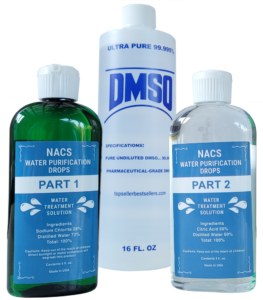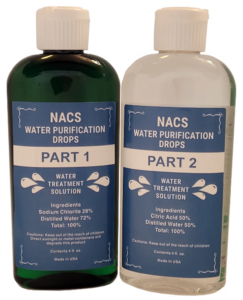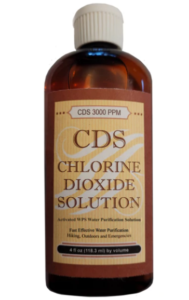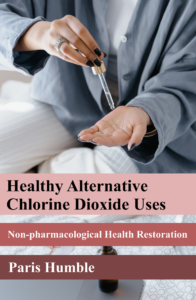Chlorine Dioxide Therapy (CDT) has gained increasing attention in recent years for its potential to address a wide range of health concerns, from microbial infections to chronic illnesses. Though its use remains controversial—especially for internal administration—many proponents claim powerful effects in detoxification, immune support, and even cancer management. This article aims to explore what CDT is, how it works, and the various ways it can be used both topically and systemically.
What Is Chlorine Dioxide?
Chlorine dioxide (ClO₂) is a yellow-green gas that dissolves in water and is known for its potent antimicrobial and oxidizing properties. Unlike common household bleach, which is sodium hypochlorite, chlorine dioxide is a non-chlorinating agent and operates through oxidation, not chlorination.
In the medical and alternative health fields, CDT refers to the use of chlorine dioxide in extremely diluted form—often just 24 parts per million (PPM)—to cleanse the body of pathogens and toxins. This is a far cry from the 500–6000 ppm concentrations used in industrial sanitation, making CDT distinct in both purpose and dosage.
How Chlorine Dioxide Works in the Body
Chlorine dioxide acts as a selective oxidizer. It reacts with negatively charged, unhealthy cells—such as viruses, bacteria, fungi, parasites, biofilms, and cancer cells—while leaving healthy, positively charged cells unaffected.
Key actions include:
- Oxidizing and destroying pathogens: Bacteria, viruses, mold, fungus, protozoa, and biofilms are highly susceptible to ClO₂.
- Neutralizing toxins: CDT eliminates heavy metals, pesticides, and herbicides.
- Supporting immune function: Internal CDT stimulates the body’s natural defenses.
- Eliminating unhealthy cells: Including reports of effectiveness against cancerous cells.
Since pathogens and toxins are involved in an estimated 95% of all diseases, CDT is seen as a wide-reaching therapy for many health challenges.
CDT Applications: Topical and Systemic
- Topical CDT Applications
Topical application is considered by many to be the safest and most accessible form of CDT. The therapy is applied directly to the skin or mucous membranes in this form.
Common uses include:
-
- Skin problems: Wounds, rashes, infections, and fungal issues.
- Dental health: As a mouthwash for halitosis, gum infections, or general oral hygiene.
- Ear canal infections: Carefully used to address outer or middle ear infections.
- MMS + DMSO Protocol (Protocol 3000): Adding DMSO (dimethyl sulfoxide) allows chlorine dioxide to penetrate deeper through the skin into the bloodstream.
- Internal / Systemic CDT Applications
Systemic use includes oral ingestion, nebulizing, and transdermal absorption (especially when combined with DMSO). Although some users claim excellent outcomes—including rapid recovery from flu, chronic illnesses, or even cancer—the safety of internal CDT remains debated, especially with long-term use.
Reported systemic benefits include:
-
- Increased energy
- Reduced inflammation
- Improved mental clarity
- Detoxification of the liver, blood, and nervous system
- Immune system enhancement
Note the long-term internal use may potentially reduce glutathione levels, the body’s master antioxidant. Therefore, it is strongly recommended that antioxidants be supplemented at least 2 hours before or after systemic CDT use to protect sensitive tissues.
MMS and CDS: Two Forms of CDT
MMS (Master Mineral Solution) is a 28% solution of sodium chlorite in distilled water, requiring activation with an acid to produce chlorine dioxide. The net sodium chlorite content is 22.4% following activation (5.6% inert salts). This process creates a powerful chlorine dioxide aqueous gas solution that is extremely popular for use as water purification drops.
Weak acids like citric acid (50% citric acid/distilled water preferred), vinegar, or lemon juice are used for internal ClO₂ applications.
Chlorine Dioxide Solution (CDS)
Chlorine Dioxide Solution or CDS is pre-activated chlorine dioxide gas distilled in water and must be refrigerated and stored below 11°C (52°F) to retain potency. This process produces a pure 22.4% solution with no inert salts and is reported to have a much more agreeable taste compared to MMS, though it is more expensive. Instructions may be found online to make your own DIY CDS from the less expensive two-part solution at home.
Example CDT Protocols
✦ Topical CDT
- For wounds, infections, and rashes: Apply activated MMS in distilled water or CDS directly to the affected area.
- For systemic absorption: Combine MMS with DMSO and rub onto clean, dry skin.✦ Oral CDT (MMS Protocol 1000)
- 3 drops activated MMS (or 24 drops CDS) in 4 oz of water.
- Taken up to 8 times per day for chronic conditions.
- Always follow with antioxidant supplementation.
✦ Oral Cancer Protocol (MMS Protocol 2000)
- Higher doses are used cautiously under supervision, sometimes combined with CDS enemas or capsules.
✦ Dental CDT
- Add 2–3 drops activated MMS to water and swish for 30 seconds.
- Repeat twice daily for oral health and breath freshness.
✦ Ear Infection CDT
- A diluted solution of activated MMS is carefully dripped into the ear canal (only under guidance or when the eardrum is intact).
Chlorine Dioxide Therapy has been used as an alternative therapy for more than 70 years, beginning with sodium chlorite. Many report benefits such as:
“It overcomes colds in an hour or so, flu in under 12 hours, pneumonia in a day, and cures more cancer than any other treatment.”
— Jim Humble, developer of MMS
Top 20 Reported Successes of Chlorine Dioxide Therapy
- Malaria (affects millions annually, especially in tropical regions).
- Diabetes (a chronic condition with rising global prevalence).
- Cancer (a leading cause of death worldwide).
- Tuberculosis (a major infectious disease, particularly in developing countries).
- Hepatitis A, B, C (viral infections with significant global impact).
- AIDS (HIV remains a global health challenge).
- COPD (a common respiratory condition).
- Alzheimer’s (and other dementias, increasingly prevalent with aging populations).
- Arthritis (affects millions, especially older adults).
- Urinary Tract Infection (UTI) (common but less severe).
- Pneumonia (a leading cause of death in vulnerable populations).
- Lupus (an autoimmune disease with varying prevalence).
- Fibromyalgia (chronic pain condition).
- Psoriasis (a skin condition affecting millions).
- Herpes (common viral infection).
- Shingles (related to chickenpox, affects older adults).
- Chron’s (a chronic inflammatory bowel disease).
- MRSA (antibiotic-resistant bacterial infection).
- Staph Infection (common bacterial infection).
- Sciatica (nerve pain condition).
Though such claims remain largely anecdotal and controversial, they continue to inspire further interest and self-experimentation among natural alternative specialists.
Safety Considerations
- Only use properly diluted solutions (e.g., 24 ppm or less) for internal use.
- Never use industrial-strength chlorine dioxide internally.
- Avoid combining CDT with vitamin C (ascorbic acid) at the same time, as it neutralizes the chlorine dioxide effect.
- Antioxidants are recommended but must be spaced several hours apart from CDT doses.
- Store all materials safely, especially MMS components and CDS.
- Always perform patch tests before topical use, especially with DMSO.
Chlorine Dioxide Therapy (CDT) presents a fascinating frontier in alternative health. From skin and dental applications to internal cleansing, it holds promise—but also demands caution and responsibility. Whether you’re experimenting with topical uses or considering more advanced internal protocols, ensure you’re informed, prepared, and respectful of the therapy’s power.
Those interested in pursuing internal CDT use are advised to consult online protocols such as:
- MMS Protocol 1000 (basic systemic use)
- MMS Protocol 2000 (for life-threatening illness)
- MMS Protocol 3000 (DMSO + chlorine dioxide for topical treatment)
- MMS Protocol 4000 (using calcium hypochlorite)
And most importantly: Start low, go slow, and listen to your body.






Leave a Reply